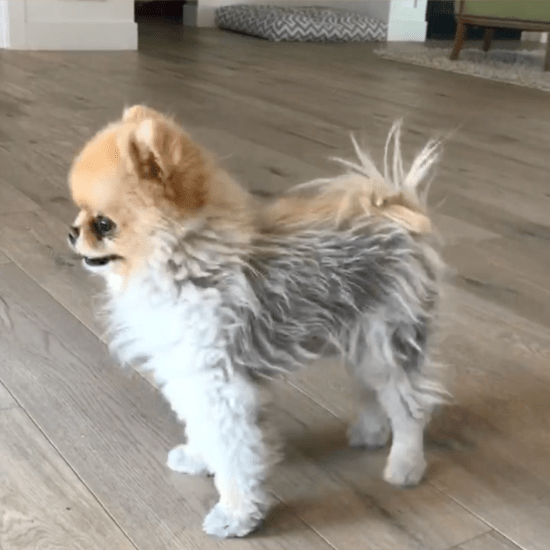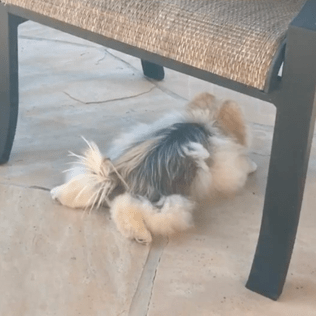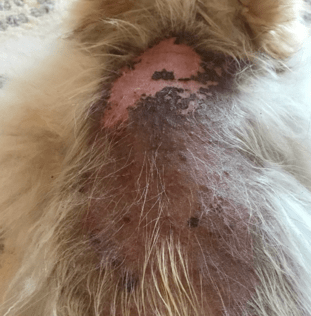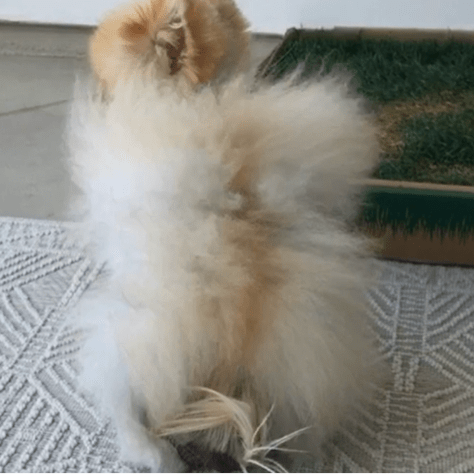
Dear Hoomans,
Repeat After Us:
Doggos don’t care if they have no hair

Watch my Hairy Tale
In 2017 I started losing my hair. I didn’t care! Actually, got more treats, cuddles, and walkies! Wee! But it was hard on hooman because she thought something was wrong. And other hoomans started calling me Alopecia. So, we tried everything to get my hairs back. Melatonin, acupuncture, the lamb & beefy raw diet, and finally a lotion that smelled like eggies. Hoomans…here’s what worked and what didn’t…and reasons life is even better, less hairy.
The Journey by Photos
The Journey by Photos





The Journey by Photos
What is Alopecia?
Dis section written by hooman. (Why it’s less gud)
TREATING ALOPECIA
What are the steps you should take when you notice fur loss in a pom or double coated doggo?
Find out if your doggo was spayed or neutered
get help from the pros
Bloodwork
Ask your vet for bloodwork to rule out medical conditions or hormonal imbalance
Discuss with your vet & advocate for testing
When your pom starts to lose his or her hair it is incredibly stressful. First, because hair is their superpower and, second, you panic that something is wrong with their health. Or you are doing something wrong, like feeding them food they are allergic to. You also get a lot of unsolicited advice and even blame from strangers as they pet & admire your sweet doggo. But try to relax because this is common in poms and if you follow the right steps it’s very likely you can get back to fluffy! I had trouble finding enough information online and also had trouble getting straight answers from medical professionals since it is still a bit of a mystery. I would recommend bloodwork out of the gate to ensure hormone levels are okay and there aren’t any medical issues. Alopecia X is really diagnosed once all other issues are ruled out. And although it’s still upsetting, in a way this is really good news if your doggo is happy and healthy. #perspective Our very well respected and beloved (traditional) vet was unfazed by Seb’s hair loss and said about 38% of Pom’s have Alopecia X and it’s nothing to worry about medically. From my experience, vet’s brush it off as a cosmetic condition and often miss things that could be contributing to hair loss. This is why I always tell pom mom’s to be their doggo’s advocate. I did my own research and read about hypothyroidism causing hair loss and my vet said it would be very rare at his age and wasn’t worth the test. However, I noticed Seb started to gain a little weight and get lethargic. I took him to a naturopath/holistic vet who immediately tested him and found he was in fact, Hypothyroid. This WAS contributing to his hair loss but a dermatologist warned us that he may ALSO have Alopecia X on top of it. Which turned out to be true.
See a naturopath and dermatologist
For the above reason. I think naturopaths are more focused on getting to the root of the issue and taking the time to think about prevention rather than reactive care. We tried acupuncture on Sebastien (increases blood flow and circulation which can stimulate hair growth) which he enjoyed but ultimately the thyroid test was an important piece of our puzzle and when we put Seb on Levothyroxine he did gain some of his hair back but most importantly his energy and vibrant personality! And bonus this manageable condition allows seb to get a thyroid treat morning and night which is the highlight of his day. I had his medicine compounded into a chewy beef flavored treat that he adores. A dermatologist can rule out issues like allergies, fleas, or yeast infections.
Consider treatments & supplements

Treatments to try :
Melatonin
Dermatologists often suggest Melatonin as a starting point since a small percentage of dogs see a response from this. Melatonin is a sleep aid for humans but can stimulate hair growth in dogs. We didn’t see any change from Melatonin.
Flaxseed oil or Fish Oil
We also tried adding flaxseed oil to Seb’s food and were told the Barlean’s brand with Lignans was best for a skin condition. Flax Seed oil contains a high quantity of Omega 3 fatty acids (healthy fat) which can improve the coat and skin conditions in dogs. Fish Oil is also a great anti-inflammatory. The omega-3’s in both oils can help open up hair follicles and promote hair growth! Bonus, they help inflammation in the joints, can relieve allergies, and support heart and eye health. Fish Oils may also help tear stains. Just use in moderation because they are high in calories and a doggo can put on weight quickly. They can also cause loose poops for a bit so start with a low dose. p.s. Many vets will say you don’t need these supplements if you are feeding a well balanced meal. Just like a lot of human doctors don’t think we need vitamins or supplements!
Emu Oil
We were told Emu oil (Oil from the Emu which is a bird native to Australia) is especially effective in hair growth. Emu oil has been used to relieve minor aches and pains, help wounds heal quicker, and protect skin in Australian Aborigine culture. It’s fantastic as an anti-inflammatory. We had trouble finding one we trusted, so we didn’t try it.
Hypoallergenic Shampoos
Always be careful with shampoos and conditioners and ensure they are hypoallergenic and calming to the skin. Most of these soap-free formulas use natural ingredients like aloe vera and vitamin E that are soothing and eliminate perfumes, fragrances, dyes, and sulfates. We love Douxo Chlorhexidine PS (worst name ever but fantastic) which is an antiseptic lathering solution which can control irritation, itching, and control bacteria and fungi. Hoomans swear by it for their doggos with allergies and itching and dermatologists also recommend it for Poms with Alopecia.
Micro Needling
Micro Needling involves a roller of tiny needles being rolled over the skin creating tiny punctures and putting the skin into healing mode. The theory is, the inflammation associated with healing will awaken the hair follicles in that area. This procedure is widely used in hooman aesthetics to generate collagen, remove wrinkles, and brighten the skin complexion. I believe it would work well since I’ve noticed Sebastien grows hair wherever he’s had a small incision. Your doggo would have to be put under anesthesia since the needles can be painful and since Alopecia is a cosmetic concern most owners don’t want their doggos to endure any pain.
Deslorelin Implants
Deslorelin is a veterinary hormone that curtails the production of estrogen and testosterone and is usually used to time ovulation in mares. It is available as an implant and was recently tested in alopecia X. Within three months, 60 percent of the unneutered male dogs experienced hair regrowth. None of the spayed females experienced hair regrowth. No side effects were noted during the one-year period of testing. This may pan out as a treatment strategy for unneutered male dogs.
Transition to a raw or kibble free diet
Diet is the trickiest topic for dog owners. Many of the best vets in the US think Kibble is just fine and raw diets are unnecessary or even harmful. Our vet did not think food had any connection to Alopecia since it was a “hereditary condition”.
However, it’s hard to ignore the link between nutrition, gut health and healthy skin. Hoomans eat anti-inflammatory diets, take probiotics, and other gut supplements to ensure the gut flora is healthy and not “leaking” toxins into the bloodstream. Many experts believe that processed treats and kibbles (as well as antibiotics, heartworm/flea medications, and rabies vaccines) can cause yeast buildup which can contribute to black skin disease.
 see what Seb eats
see what Seb eats 
try Dermagic Lotion
I read about Dermagic for years and wish I had tried it right when Seb started losing his hair. I was so careful about putting anything on Seb’s precious skin and worried about making anything worse. People started reaching out to us on Instagram and telling us how Dermagic worked for them….so I finally felt confident and gave it a shot! I’m so glad we did because it worked! You must be patient (our process took 5 months) and it’s smelly and sticky but I grew to love Seb’s time in his cute tee-shirts and when the hair grew back it felt like a miracle! If your pom has bald black skin use the skin rescue lotion Use restoration crème on pink healthy areas The scientists and creators behind Dermagic believe that black skin is just raging yeast and the causes are shaving, poor diet, and medications/vaccines/antibiotics. They report that vaccines contain antibiotics which set off yeast issues. And believe that every pet has a healthy amount of yeast on their skin, but when they are shaved, the yeast gets injected into deeper layers of the skin and takes over. If gut flora is in balance and there isn’t a yeast problem to begin with, the shaving won’t cause this problem. They believe food is medicine and immunity is what protects a doggo from illness and disease. However, most vets and dog owners agree vaccines and antibiotics are necessary and hard to avoid. The makers of Dermagic believe in natural heart worm and flea preventatives and believe vaccines last the lifetime of a pet. They recommend getting a Titer test done (blood test) to avoid over vaccination. This test checks for antibodies, viruses, and disease. It was hard for me to read all of this as someone who tries to avoid antibiotics, processed foods, and toxins herself. Thinking I could be harming Sebastien by giving him preventative treatments the vet recommended was overwhelming. But I wanted to present all views of the Alopecia condition so you can use your best judgments when it comes to your doggo. Sebastien had a few anal gland infections in 2020 and had to be put on antibiotics and steroids for a few months and I did notice he started losing the gorgeous back hair he grew back on Dermagic. But I continue to give him the medications vet’s recommend because I haven’t found natural alternatives that don’t also pose risks. All we can do is our best and the fact that you are reading this means your doggo is very lucky!

In Poms like Sebastien, many owners notice the onset of Alopecia to coincide with a short shaving or haircut. (even scissoring). Poms have two coats, as most spitz breeds do. The pom originated from larger cold weather sled dogs of the Arctic. The trait of having two layers is common with outdoor dogs and even though the pom was bred down in size, the trait of 2 layers stayed with the breed.
This matter because if that top layer is shaved or the clipper goes into the protective inner layer of fur- it can affect the hair follicles and how the hair grows back. Hair growth is often impeded so many pom owners mention that a short hair cut was the start of Alopecia. We don’t really know if it’s the cause or if it just sped up the process and Alopecia was inevitable. Professional groomers should always warn their customers that a short hair cut on a double coated doggo could result in hair loss.

